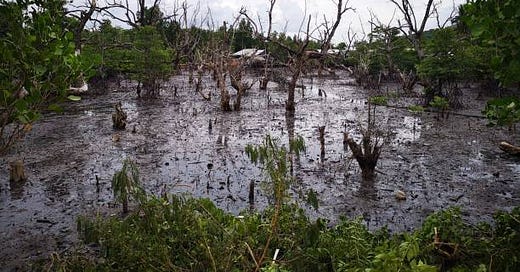Yesterday, I found myself at an ACF Brisbane Northside/Regen Brisbane workshop event about urban heat—because, apparently, I like my existential climate dread served with a side of flip charts, PowerPoint slides and name tags. The session took a ‘strategic doing’ approach, which is a fancy way of saying, “We all agree this is a problem. Now what?” The framework of the day? Doughnut Economics—because nothing keeps sustainability pundits engaged like the subtle promise of pastries.
A room full of problem-solvers (and me)
The workshop pulled together an eclectic mix of urban planners, sustainability advocates, community organisers, students and people who probably just wanted free coffee and Tim Tams. We all had the same general mission: figure out how to stop our cities from turning into literal ovens. Naturally, we covered all the usual hits: more street trees, verge gardens, better public transport, white roofs, and enough green space to make a koala weep with joy.
Urban heat needs more than just shade trees and good intentions.
But the real gem of the day? The moment we collectively realised that maybe, just maybe, we’re spending too much time on the ‘high ground’ of planning and not enough time wading through the messy, swampy reality of what actually happens when people live in these heat-stricken areas.
The ‘swamp’ of lived experience (aka my personal muddy nightmare)
This epiphany came courtesy of the concept of high ground vs swampy lowlands being shared in the room:
"On the high ground, manageable problems lend themselves to solutions through the use of research-based theory and technique. In the swampy lowlands, problems are messy and confusing and incapable of technical solution. The irony of this situation is that the problems of the high ground tend to be relatively unimportant to individuals or society at large, however great their technical interest may be, while in the swamp lie the problems of greatest human concern." ~ Donald Schön
Cue the uncomfortable realisation: I, too, am guilty of hanging out on the high ground. It’s nice up there! It’s full of data, reports, well-structured policy recommendations, and the comforting illusion that if we just plan hard enough, we can solve everything with logic and spreadsheets. Meanwhile, in the ‘swamp,’ people are just trying to survive another summer in an apartment with no airflow, while people like me are still debating what shade tree species is best.
And let’s be honest—if I had a choice between staying clean and pristine on the high ground or wading into an actual swamp? I’d be picking the dry ground every single time. I am, at heart, someone who prefers sidewalks over hiking trails and believes strongly in the value of keeping my shoes unsoiled. But if solving urban heat means getting a little muddy—both metaphorically and possibly literally—it’s time to reconsider my aversion.
Let’s get swampy (No, really!)
The real challenge—and the most interesting part of the workshop—was figuring out how to better connect the high-ground professionals (urban planners, policymakers, sustainability consultants) with the people who live and breathe urban heat every day. Not in a “Let’s have a one-time community consultation and feel good about ourselves” kind of way, but in an “Ongoing, reciprocal relationships where we actually listen and act on lived experience” kind of way.
Because here’s the thing: a resident who has spent five summers roasting in an unshaded, heat-trapped suburb knows way more about the problem than our best GIS heat-mapping tools. A bus driver navigating a heat-absorbing concrete jungle has insights that simply don’t show up in planning meetings. And yet, these voices are often drowned out by policy jargon and PowerPoint decks.
So, What Now?
Stop treating lived experience like an afterthought. If we want real solutions, we need to make community voices central—not just a box to tick after the “real” planning is done.
Expand the definition of ‘expert.’ Some of the best knowledge about urban heat is held by the people living through it, not just those with degrees and job titles.
Embrace the mess. The swamp is chaotic, full of contradictions, and rarely offers neat solutions. But that’s where the real work happens. If you’re not at least a little bit uncomfortable, you’re probably still on the high ground.
Urban heat is a massive problem, and our usual solutions—while necessary—are often too sterile, too structured, and too disconnected from the real-world chaos of an increasing hot city. If we want to make meaningful progress, we need to wade into the swamp, embrace the complexity, and—dare I say—get a little ahhhm… muddy. Because while the high ground might be comfortable (a nice and clean), the answers we need are waiting for us in the mess.
Traditional problem solving relies on a linear process of steps towards the ‘strategic’ solution. In contrast, Strategic Doing is agile and iterative, often taking a zig-zag path.
Using the strategic doing model of non-linear progress, we’re taking the first few steps to explore practical ways of bridging this gap. That starts with making contact with planning students and professional bodies—and trying to pull together a workshop of event to bring the two perspectives together to ensure future professionals are equipped not just with technical knowledge, but with a deep understanding of the messy, human realities of urban heat. But also, to help grassroots community people to understand the challenges the professionals are facing in the high ground. Because real change isn’t just about policy—it’s about people understanding and collaborating. So yes, I will begrudgingly step into the metaphorical (and possibly real) mud—because if that’s where the solutions are, it’s time to get dirty. (It might even be fun!)








I love this perspective, it captures the workshop discussion/insights well that mostly come from the high ground. And its true, we can all get better at stepping into and appreciating the swampy places. See you there...:)